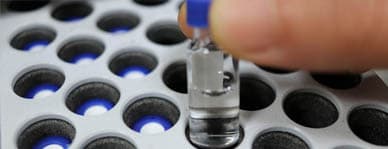Hy-Blocks Hyaluronidase Ophthalmic Blocks
Edge Pharma is an FDA-Registered 503B Outsourcing Facility which specializes in providing compounded sterile ophthalmic blocks, which are premixed ready-to-administer retrobulbar and peribulbar ophthalmic blocks dispensed in unit dose syringes.
Hy-Blocks Ophthalmic Blocks
Sterile ophthalmic solution for injection (PF) in single use syringe.
Storage: refrigerate and protect from light.
- Bupivacaine 0.375% / Lidocaine 2% / Hyaluronidase 15 units/ml available in 8mL dose.
- Epinephrine 1:400,000 / Lidocaine 3% / Hyaluronidase 15 units/ml available in 5mL dose.
Outsourcing the compounding of these medications with Edge offers several distinct advantages compared with in-house compounding with the hospital pharmacy or surgery center.
- USP 797 Compliance
- Waste Reduction
- Efficiency — no additional compounding required
- Sterility, potency, and endotoxin testing performed on every batch.
The History of Hyaluronidase
The story of hyaluronidase, a component in many ophthalmic anesthesia blocks, begins in 1911 in a New York City laboratory, with a researcher who was studying not eye surgery or even human anatomy, but instead — cancer in chickens.
“Rous Chicken Carcinoma,” named for the pathologist who first discovered it, proved that a virus could cause cancer.(1) Dr. Peyton Rous, working in a Rockefeller University lab, minced a sample of tumor tissue from a chicken and prepared an extract which he mixed with saline. He ran the extract through a filter which eliminated bacteria and cancer cells. When he injected the extract into healthy chickens, they developed new tumors.(1) In 1966, Rous received the Nobel Prize for this discovery of tumor-inducing viruses.(2)
Another researcher, Francisco Duran-Reynals, who came to the U.S. from the Institut Pasteur in Paris, worked on the Rous Chicken Carcinoma project. In 1928, Duran-Reynols discovered that if he added testicular extract and mixed it with the saline/virus solution, he could increase the “spreading factor” of the virus that had caused the cancer.(3) “The discovery led Duran to suspend his research on cancer, and to begin an important series of experiments on spreading factors,” according to an article in “Contributions to Science.” Duran-Reynals went on to demonstrate the spreading phenomenon with other viruses, dyes, and toxins.(3) The enzyme in the extracts was named hyaluronidase.(4)
Years later, hyaluronidase came into use to improve the dispersion of medications.(5) In ophthalmology, hyaluronidase is often added to ophthalmic blocks to help diffuse anesthetic and to quicken its onset. According to an article in The Journal of Applied Research, “Rationale for the inclusion of hyaluronidase in combination with local anesthesia techniques includes smaller increases in intraocular pressure, less distortion of the surgical site, decreased incidence of postoperative strabismus, and potential of limiting local anesthesia myotoxicity because of the quicker spread. In some studies, inclusion of hyaluronidase increased globe and lid akinesia, which may improve the safety of the procedure.”(5)
Edge Pharma produces unit-doses of Bupivacaine/Lidocaine/Hyaluronidase, and Epinephrine/Lidocaine/Hyaluronidase. The prefilled syringes make it easy for hospitals and surgery centers to utilize these medications without needing to compound the doses at their facilities.
(1) The Rockefeller University, Discovering the First Cancer-Causing Virus, http://centennial.rucares.org/
(2) Nobel Prize Summary, https://www.nobelprize.org/
(3) Glick, T., and Rosell, A., Contributions to Science, Virus and Cancer: A Controversial Theory, https://www.researchgate.net/
(4) Hobby, G. PhD, et al, Department of Medicine and Ophthalmology, Columbia University College of Physicians and Surgeons, The Relationship Between Spreading Factor and Hyaluronidase, https://pubmed.ncbi.nlm.nih.gov/19871061/
(5) Silverstein, S. MD, The Journal of Applied Research, Hyaluronidase in Ophthalmology, http://www.jrnlappliedresearch.com/
Testimonials
“Edge Pharmacy Services worked with us in developing our block mixture over 2 years ago. Since that time we have performed over 20,000 blocks at various sites in New York and New England. The performance of the blocks has been outstanding. We receive our blocks in a timely and secure manner. Given the recent environment surrounding the compounding of medications and the challenges providers face, Edge Pharmacy Services has allowed us to continue to provide our patients and centers with the quality and safety they deserve.”
Stephan Hatch MD
Clinical Director, JJM Medical
References
1) Nicoll, J. Martin V., et al. “Retrobulbar Anesthesia: The Role of Hyaluronidase.” Anesthesia & Analgesia 65.12 (1986): 1324-1328.
“The improved efficacy of retrobulbar block by the addition of hyaluronidase to the local anesthetics was clearly demonstrated by the trial.”
“Originally the authors were skeptical that any difference at all would be demonstrated, and a far larger trial had been contemplated. However, on completion of this number [100] it was clear that to continue to perform retrobulbar block without the addition of hyaluronidase would be unjustified.”
2) Dempsey, G. A., P. J. Barrett, and I. J. Kirby. “Hyaluronidase and Peribulbar Block.” British journal of anaesthesia 78.6 (1997): 671-674.
“Each time a needle is introduced into the orbit, there is a small but definite risk of complication. Successful block from a single injection is therefore desirable. Our study has shown that this is most likely to be achieved when hyaluronidase is added to the solution.”
3) Kallio, Helena, Markku Paloheimo, and Eeva-Liisa Maunuksela. “Hyaluronidase as an Adjuvant in Bupivacaine-Lidocaine Mixture for Retrobulbar/Peribulbar Block.” Anesthesia & Analgesia 91.4 (2000): 934-937.
“The addition of hyaluronidase significantly improved the success of the motor block.”
“Supplementary blocks were needed significantly more often when the local anesthetic solution was hyaluronidase-free.”
Register To Order Online
We are currently licensed to sell to all US states except Alabama and Virginia. Please fill the Form below to create an account. Medical, DEA, or hospital pharmacy licenses will be required to order prefilled verapamil syringes.
Create an account to order
Log-In if you have an account

